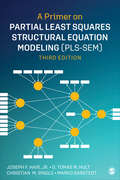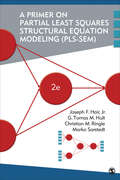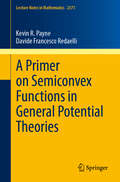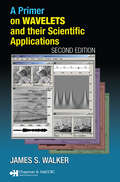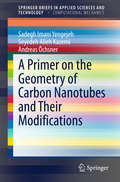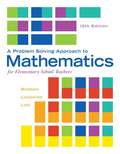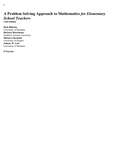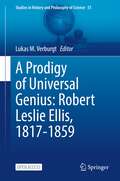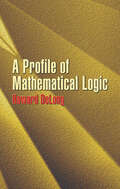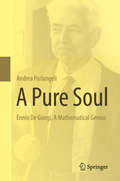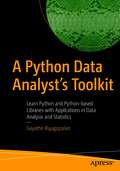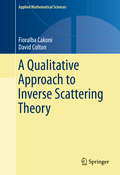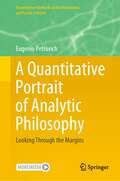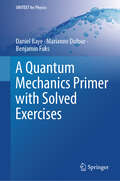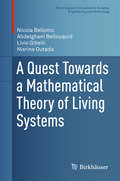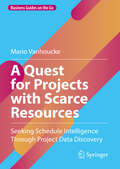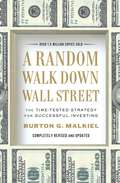- Table View
- List View
A Primer on Partial Least Squares Structural Equation Modeling (PLS-SEM)
by G. Tomas Hult Marko Sarstedt Christian M. Ringle Joe HairThe third edition of A Primer on Partial Least Squares Structural Equation Modeling (PLS-SEM) guides readers through learning and mastering the techniques of this approach in clear language. Authors Joseph H. Hair, Jr., G. Tomas M. Hult, Christian Ringle, and Marko Sarstedt use their years of conducting and teaching research to communicate the fundamentals of PLS-SEM in straightforward language to explain the details of this method, with limited emphasis on equations and symbols. A running case study on corporate reputation follows the different steps in this technique so readers can better understand the research applications. Learning objectives, review and critical thinking questions, and key terms help readers cement their knowledge. This edition has been thoroughly updated, featuring the latest version of the popular software package SmartPLS 3. New topics have been added throughout the text, including a thoroughly revised and extended chapter on mediation, recent research on the foundations of PLS-SEM, detailed descriptions of research summarizing the advantages as well as limitations of PLS-SEM, and extended coverage of advanced concepts and methods, such as out-of-sample versus in-sample prediction metrics, higher-order constructs, multigroup analysis, necessary condition analysis, and endogeneity.
A Primer on Partial Least Squares Structural Equation Modeling (PLS-SEM)
by G. Tomas Hult Marko Sarstedt Christian M. Ringle Joe HairThe third edition of A Primer on Partial Least Squares Structural Equation Modeling (PLS-SEM) guides readers through learning and mastering the techniques of this approach in clear language. Authors Joseph H. Hair, Jr., G. Tomas M. Hult, Christian Ringle, and Marko Sarstedt use their years of conducting and teaching research to communicate the fundamentals of PLS-SEM in straightforward language to explain the details of this method, with limited emphasis on equations and symbols. A running case study on corporate reputation follows the different steps in this technique so readers can better understand the research applications. Learning objectives, review and critical thinking questions, and key terms help readers cement their knowledge. This edition has been thoroughly updated, featuring the latest version of the popular software package SmartPLS 3. New topics have been added throughout the text, including a thoroughly revised and extended chapter on mediation, recent research on the foundations of PLS-SEM, detailed descriptions of research summarizing the advantages as well as limitations of PLS-SEM, and extended coverage of advanced concepts and methods, such as out-of-sample versus in-sample prediction metrics, higher-order constructs, multigroup analysis, necessary condition analysis, and endogeneity.
A Primer on Partial Least Squares Structural Equation Modeling (PLS-SEM)
by G. Tomas Hult Marko Sarstedt Dr Joe Hair Dr Christian M. RingleA Primer on Partial Least Squares Structural Equation Modeling (PLS-SEM) by Joseph F. Hair, Jr., G. Tomas M. Hult, Christian Ringle, and Marko Sarstedt is a practical guide that provides concise instructions on how to use partial least squares structural equation modeling (PLS-SEM), an evolving statistical technique, to conduct research and obtain solutions. Featuring the latest research, new examples using the SmartPLS software, and expanded discussions throughout, the Second Edition is designed to be easily understood by those with limited statistical and mathematical training who want to pursue research opportunities in new ways.
A Primer on Partial Least Squares Structural Equation Modeling (PLS-SEM)
by G. Tomas Hult Marko Sarstedt Dr Joe Hair Dr Christian M. RingleA Primer on Partial Least Squares Structural Equation Modeling (PLS-SEM) by Joseph F. Hair, Jr., G. Tomas M. Hult, Christian Ringle, and Marko Sarstedt is a practical guide that provides concise instructions on how to use partial least squares structural equation modeling (PLS-SEM), an evolving statistical technique, to conduct research and obtain solutions. Featuring the latest research, new examples using the SmartPLS software, and expanded discussions throughout, the Second Edition is designed to be easily understood by those with limited statistical and mathematical training who want to pursue research opportunities in new ways.
A Primer on Population Dynamics Modeling: Basic Ideas for Mathematical Formulation (Theoretical Biology)
by Hiromi SenoThis textbook provides an introduction to the mathematical models of population dynamics in mathematical biology. The focus of this book is on the biological meaning/translation of mathematical structures in mathematical models, rather than simply explaining mathematical details and literacies to analyze a model. In some recent usages of the mathematical model simply with computer numerical calculations, the model includes some inappropriate mathematical structure concerning the reasonability of modeling for the biological problem under investigation. For students and researchers who study or use mathematical models, it is important and helpful to understand what mathematical setup could be regarded as reasonable for the model with respect to the relation between the biological factors involved in the assumptions and the mathematical structure of the model. Topics covered in this book are; modeling with geometric progression, density effect in population dynamics, deriving continuous time models from discrete time models, basic modeling for birth-death stochastic processes, continuous time models, modeling interspecific reaction for the continuous time population dynamics model, competition and prey-predator dynamics, modeling for population dynamics with a heterogeneous structure of population, qualitative analysis on the discrete time dynamical system, necessary knowledge about fundamental mathematical theories to understand the dynamical nature of continuous time models. The book includes popular topics in ecology and mathematical biology, as well as classic theoretical topics. By understanding the biological meaning of modeling for simple models, readers will be able to derive a specific mathematical model for a biological problem by reasonable modeling. The contents of this book is made accessible for readers without strong Mathematical background.
A Primer on Semiconvex Functions in General Potential Theories (Lecture Notes in Mathematics #2371)
by Kevin R. Payne Davide Francesco RedaelliThis book examines the symbiotic interplay between fully nonlinear elliptic partial differential equations and general potential theories of second order. Starting with a self-contained presentation of the classical theory of first and second order differentiability properties of convex functions, it collects a wealth of results on how to treat second order differentiability in a pointwise manner for merely semicontinuous functions. The exposition features an analysis of upper contact jets for semiconvex functions, a proof of the equivalence of two crucial, independently developed lemmas of Jensen (on the viscosity theory of PDEs) and Slodkowski (on pluripotential theory), and a detailed description of the semiconvex approximation of upper semicontinuous functions. The foundations of general potential theories are covered, with a review of monotonicity and duality, and the basic tools in the viscosity theory of generalized subharmonics, culminating in an account of the monotonicity-duality method for proving comparison principles. The final section shows that the notion of semiconvexity extends naturally to manifolds. A complete treatment of important background results, such as Alexandrov&’s theorem and a Lipschitz version of Sard&’s lemma, is provided in two appendices. The book is aimed at a wide audience, including professional mathematicians working in fully nonlinear PDEs, as well as master&’s and doctoral students with an interest in mathematical analysis.
A Primer on Wavelets and Their Scientific Applications (Studies in Advanced Mathematics)
by James S. WalkerIn the first edition of his seminal introduction to wavelets, James S. Walker informed us that the potential applications for wavelets were virtually unlimited. Since that time thousands of published papers have proven him true, while also necessitating the creation of a new edition of his bestselling primer. Updated and fully revised to include th
A Primer on the Dirichlet Space
by Omar El-FallahThe Dirichlet space is one of the three fundamental Hilbert spaces of holomorphic functions on the unit disk. It boasts a rich and beautiful theory, yet at the same time remains a source of challenging open problems and a subject of active mathematical research. This book is the first systematic account of the Dirichlet space, assembling results previously only found in scattered research articles, and improving upon many of the proofs. Topics treated include: the Douglas and Carleson formulas for the Dirichlet integral, reproducing kernels, boundary behaviour and capacity, zero sets and uniqueness sets, multipliers, interpolation, Carleson measures, composition operators, local Dirichlet spaces, shift-invariant subspaces, and cyclicity. Special features include a self-contained treatment of capacity, including the strong-type inequality. The book will be valuable to researchers in function theory, and with over 100 exercises it is also suitable for self-study by graduate students.
A Primer on the Geometry of Carbon Nanotubes and Their Modifications (SpringerBriefs in Applied Sciences and Technology)
by Andreas Öchsner Sadegh Imani Yengejeh Seyedeh Alieh KazemiThis volume presents a comprehensive system for categorizing carbon nanotubes and their modifications in terms of nano sheets, nanotubes, microscopic and atomic modifications. In addition, the material and geometric properties of these nano-configurations are addressed. Lastly, it introduces a number of common software packages for geometry generation and several commercial finite element programs.
A Problem Solving Approach To Mathematics For Elementary School Teachers
by Rick Billstein Shlomo Libeskind Johnny LottA Problem Solving Approach to Mathematics for Elementary School Teachers
A Problem Solving Approach to Mathematics for Elementary School Teachers
by Rick Billstein Johnny W. Lott Shlomo Libeskind Barbara BoschmansA Problem Solving Approach to Mathematics for Elementary School Teachers not only helps students learn the math - it provides an invaluable reference to future teachers by including professional development features and discussions of today's standards. <p><p> Revised throughout to prepare students more effectively for their own classrooms, the 13th Edition gives instructors a variety of approaches to teaching, and encourages discussion and collaboration among students and with their instructors. The MyLab(TM) Math course for this revision is updated extensively with new resources and features.
A Problem Solving Approach to Mathematics for Elementary School Teachers
by Rick Billstein Shlomo Libeskind Johnny LottMore than 350,000 students have prepared for teaching mathematics with A Problem Solving Approach to Mathematics for Elementary School Teachers since its first edition, and it remains the gold standard today. This text not only helps students learn the material by promoting active learning and developing skills and concepts--it also provides an invaluable reference to future teachers by including professional development features and discussions of today's standards. The Eleventh Edition is streamlined to keep students focused on what is most important. The Common Core State Standards (CCSS) have been integrated into the book to keep current with educational developments.
A Prodigy of Universal Genius: Robert Leslie Ellis, 1817-1859 (Studies in History and Philosophy of Science #55)
by Lukas M. VerburgtThis open access book brings together for the first time all aspects of the tragic life and fascinating work of the polymath Robert Leslie Ellis (1817–1859), placing him at the heart of early-Victorian intellectual culture. Written by a diverse team of experts, the chapters in the book’s first part contain in-depth examinations of, among other things, Ellis’s family, education, Bacon scholarship and mathematical contributions. The second part consists of annotated transcriptions of a selection of Ellis’s diaries and correspondence. Taken together, A Prodigy of Universal Genius: Robert Leslie Ellis, 1817–1859 is a rich resource for historians of science, historians of mathematics and Victorian scholars alike. Robert Leslie Ellis was one of the most intriguing and wide-ranging intellectual figures of early Victorian Britain, his contributions ranging from advanced mathematical analysis to profound commentaries on philosophy and classics and a decisive role in the orientation of mid-nineteenth century scholarship. This very welcome collection offers both new and authoritative commentaries on the work, setting it in the context of the mathematical, philosophical and cultural milieux of the period, together with fascinating passages from the wealth of unpublished papers Ellis composed during his brief and brilliant career.- Simon Schaffer, Department of History and Philosophy of Science, University of Cambridge
A Profile of Mathematical Logic
by Howard DelongAnyone seeking a readable and relatively brief guide to logic can do no better than this classic introduction. A treat for both the intellect and the imagination, it profiles the development of logic from ancient to modern times and compellingly examines the nature of logic and its philosophical implications. No prior knowledge of logic is necessary; readers need only an acquaintance with high school mathematics. The author emphasizes understanding, rather than technique, and focuses on such topics as the historical reasons for the formation of Aristotelian logic, the rise of mathematical logic after more than 2,000 years of traditional logic, the nature of the formal axiomatic method and the reasons for its use, and the main results of metatheory and their philosophic import. The treatment of the Gödel metatheorems is especially detailed and clear, and answers to the problems appear at the end.
A Project-Based Guide to Undergraduate Research in Mathematics: Starting and Sustaining Accessible Undergraduate Research (Foundations for Undergraduate Research in Mathematics)
by Aaron Wootton Pamela E. Harris Erik InskoThis volume provides accessible and self-contained research problems designed for undergraduate student projects, and simultaneously promotes the development of sustainable undergraduate research programs. The chapters in this work span a variety of topical areas of pure and applied mathematics and mathematics education. Each chapter gives a self-contained introduction on a research topic with an emphasis on the specific tools and knowledge needed to create and maintain fruitful research programs for undergraduates. Some of the topics discussed include:• Disease modeling• Tropical curves and surfaces• Numerical semigroups• Mathematics EducationThis volume will primarily appeal to undergraduate students interested in pursuing research projects and faculty members seeking to mentor them. It may also aid students and faculty participating in independent studies and capstone projects.
A Proof Theory for Description Logics (SpringerBriefs in Computer Science)
by Alexandre RademakerDescription Logics (DLs) is a family of formalisms used to represent knowledge of a domain. They are equipped with a formal logic-based semantics. Knowledge representation systems based on description logics provide various inference capabilities that deduce implicit knowledge from the explicitly represented knowledge. A Proof Theory for Description Logics introduces Sequent Calculi and Natural Deduction for some DLs (ALC, ALCQ). Cut-elimination and Normalization are proved for the calculi. The author argues that such systems can improve the extraction of computational content from DLs proofs for explanation purposes.
A Pure Soul: Ennio De Giorgi, A Mathematical Genius
by Andrea ParlangeliThis biography illuminates the life of Ennio De Giorgi, a mathematical genius in parallel with John Nash, the Nobel Prize Winner and protagonist of A Beautiful Mind. Beginning with his childhood and early years of research, into his solution of the 19th problem of Hilbert and his professorship, this book pushes beyond De Giorgi’s rich contributions to the mathematics community, to present his work in human rights, including involvement in the fight for Leonid Plyushch’s freedom and the defense of dissident Uruguayan mathematician José Luis Massera. Considered by many to be the greatest Italian analyst of the twentieth century, De Giorgi is described in this volume in full through documents and direct interviews with friends, family, colleagues, and former students.
A Pythagorean Introduction to Number Theory: Right Triangles, Sums of Squares, and Arithmetic (Undergraduate Texts in Mathematics)
by Ramin Takloo-BighashRight triangles are at the heart of this textbook’s vibrant new approach to elementary number theory. Inspired by the familiar Pythagorean theorem, the author invites the reader to ask natural arithmetic questions about right triangles, then proceeds to develop the theory needed to respond. Throughout, students are encouraged to engage with the material by posing questions, working through exercises, using technology, and learning about the broader context in which ideas developed. Progressing from the fundamentals of number theory through to Gauss sums and quadratic reciprocity, the first part of this text presents an innovative first course in elementary number theory. The advanced topics that follow, such as counting lattice points and the four squares theorem, offer a variety of options for extension, or a higher-level course; the breadth and modularity of the later material is ideal for creating a senior capstone course. Numerous exercises are included throughout, many of which are designed for SageMath. By involving students in the active process of inquiry and investigation, this textbook imbues the foundations of number theory with insights into the lively mathematical process that continues to advance the field today. Experience writing proofs is the only formal prerequisite for the book, while a background in basic real analysis will enrich the reader’s appreciation of the final chapters.
A Python Data Analyst’s Toolkit: Learn Python and Python-based Libraries with Applications in Data Analysis and Statistics
by Gayathri RajagopalanExplore the fundamentals of data analysis, and statistics with case studies using Python. This book will show you how to confidently write code in Python, and use various Python libraries and functions for analyzing any dataset. The code is presented in Jupyter notebooks that can further be adapted and extended.This book is divided into three parts – programming with Python, data analysis and visualization, and statistics. You'll start with an introduction to Python – the syntax, functions, conditional statements, data types, and different types of containers. You'll then review more advanced concepts like regular expressions, handling of files, and solving mathematical problems with Python. The second part of the book, will cover Python libraries used for data analysis. There will be an introductory chapter covering basic concepts and terminology, and one chapter each on NumPy(the scientific computation library), Pandas (the data wrangling library) and visualization libraries like Matplotlib and Seaborn. Case studies will be included as examples to help readers understand some real-world applications of data analysis. The final chapters of book focus on statistics, elucidating important principles in statistics that are relevant to data science. These topics include probability, Bayes theorem, permutations and combinations, and hypothesis testing (ANOVA, Chi-squared test, z-test, and t-test), and how the Scipy library enables simplification of tedious calculations involved in statistics.What You'll LearnFurther your programming and analytical skills with PythonSolve mathematical problems in calculus, and set theory and algebra with PythonWork with various libraries in Python to structure, analyze, and visualize dataTackle real-life case studies using PythonReview essential statistical concepts and use the Scipy library to solve problems in statistics Who This Book Is ForProfessionals working in the field of data science interested in enhancing skills in Python, data analysis and statistics.
A Qualitative Approach to Inverse Scattering Theory (Applied Mathematical Sciences #188)
by David Colton Fioralba CakoniInverse scattering theory is an important area of applied mathematics due to its central role in such areas as medical imaging , nondestructive testing and geophysical exploration. Until recently all existing algorithms for solving inverse scattering problems were based on using either a weak scattering assumption or on the use of nonlinear optimization techniques. The limitations of these methods have led in recent years to an alternative approach to the inverse scattering problem which avoids the incorrect model assumptions inherent in the use of weak scattering approximations as well as the strong a priori information needed in order to implement nonlinear optimization techniques. These new methods come under the general title of qualitative methods in inverse scattering theory and seek to determine an approximation to the shape of the scattering object as well as estimates on its material properties without making any weak scattering assumption and using essentially no a priori information on the nature of the scattering object. This book is designed to be an introduction to this new approach in inverse scattering theory focusing on the use of sampling methods and transmission eigenvalues. In order to aid the reader coming from a discipline outside of mathematics we have included background material on functional analysis, Sobolev spaces, the theory of ill posed problems and certain topics in in the theory of entire functions of a complex variable. This book is an updated and expanded version of an earlier book by the authors published by Springer titled Qualitative Methods in Inverse Scattering Theory Review of Qualitative Methods in Inverse Scattering Theory All in all, the authors do exceptionally well in combining such a wide variety of mathematical material and in presenting it in a well-organized and easy-to-follow fashion. This text certainly complements the growing body of work in inverse scattering and should well suit both new researchers to the field as well as those who could benefit from such a nice codified collection of profitable results combined in one bound volume. SIAM Review, 2006
A Quantitative Portrait of Analytic Philosophy: Looking Through the Margins (Quantitative Methods in the Humanities and Social Sciences)
by Eugenio PetrovichThis book offers an unprecedented quantitative portrait of analytic philosophy focusing on two seemingly marginal features of philosophical texts: citations and acknowledgements in academic publications. Originating from a little network of philosophers based in Oxford, Cambridge, and Vienna, analytic philosophy has become during the Twentieth century a thriving philosophical community with thousands of members worldwide. Leveraging the most advanced techniques from bibliometrics, citations and acknowledgments are used in this book to shed light on both the epistemology and the sociology of this philosophical field, illuminating the intellectual trajectory of analytic philosophy as well as the social characteristics of the analytic community. Special attention is dedicated to the last forty years, providing insights into a phase of analytic philosophy which is still understudied by historians of philosophy. In the eight chapters of the book, readers will find not only numerous quantitative investigations and technical explanations, but also a robust theoretical framework and epistemological reflections on the strengths and limitations of quantitative methods for the study of philosophy. With its strong interdisciplinary appeal, this book will engage a wide range of scholars, including historians of philosophy seeking new methodologies, analytic philosophers interested in a new look at their discipline, and scholars in digital humanities, bibliometrics, and quantitative studies of science, who will find many innovative techniques for investigating disciplinary fields.
A Quantum Mechanics Primer with Solved Exercises (UNITEXT for Physics)
by Daniel Baye Marianne Dufour Benjamin FuksThis book provides a comprehensive introduction to quantum mechanics, supported by numerous solved exercises. Aiming to be both exhaustive and educational, it minimises overly formal aspects by presenting the wave mechanical approach to quantum mechanics. The book simplifies and rigorously covers a large set of fundamental topics such as potential wells and barriers, wave packets, harmonic oscillators, and the hydrogen atom. It also addresses spin and, in simple terms, the conceptual difficulties of quantum physics and Bell’s inequalities. The discussion extends to relativistic quantum mechanics. Each chapter includes exercises designed to test comprehension and facilitate optimal assimilation of the material, and are followed by detailed solutions. Intended for both personal study and course support, this book is valuable for anyone curious about the subject. However, it is specifically targeted at undergraduate and master’s students in physics, chemistry, and mathematics, as well as engineering students.
A Quest Towards a Mathematical Theory of Living Systems (Modeling and Simulation in Science, Engineering and Technology)
by Nicola Bellomo Abdelghani Bellouquid Livio Gibelli Nisrine OutadaThis monograph aims to lay the groundwork for the design of a unified mathematical approach to the modeling and analysis of large, complex systems composed of interacting living things. Drawing on twenty years of research in various scientific fields, it explores how mathematical kinetic theory and evolutionary game theory can be used to understand the complex interplay between mathematical sciences and the dynamics of living systems. The authors hope this will contribute to the development of new tools and strategies, if not a new mathematical theory. The first chapter discusses the main features of living systems and outlines a strategy for their modeling. The following chapters then explore some of the methods needed to potentially achieve this in practice. Chapter Two provides a brief introduction to the mathematical kinetic theory of classical particles, with special emphasis on the Boltzmann equation; the Enskog equation, mean field models, and Monte Carlo methods are also briefly covered. Chapter Three uses concepts from evolutionary game theory to derive mathematical structures that are able to capture the complexity features of interactions within living systems. The book then shifts to exploring the relevant applications of these methods that can potentially be used to derive specific, usable models. The modeling of social systems in various contexts is the subject of Chapter Five, and an overview of modeling crowd dynamics is given in Chapter Six, demonstrating how this approach can be used to model the dynamics of multicellular systems. The final chapter considers some additional applications before presenting an overview of open problems. The authors then offer their own speculations on the conceptual paths that may lead to a mathematical theory of living systems hoping to motivate future research activity in the field. A truly unique contribution to the existing literature, A Quest Toward a Mathematical Theory of Living Systems is an important book that will no doubt have a significant influence on the future directions of the field. It will be of interest to mathematical biologists, systems biologists, biophysicists, and other researchers working on understanding the complexities of living systems.
A Quest for Projects with Scarce Resources: Seeking Schedule Intelligence Through Project Data Discovery (Business Guides on the Go)
by Mario VanhouckeBased on the shared journey of two researchers, this book explores enhancing algorithms for the resource-constrained project scheduling problem. It examines the search for and significance of project data from multiple, distinct perspectives. In the first part, the quest for project data is presented as a continuous exploration of the complexity of the resource-constrained project scheduling problem. This quest is pursued by solving this challenging problem with the aid of state-of-the-art algorithms from the literature, each time gaining a deeper understanding of its challenging nature. To provide insights into the problem’s complexity, project data is created, manipulated, and analyzed in depth to make current projects easier or harder to schedule. This challenging quest for project data has resulted in new project databases for academic research, new ways of testing future algorithms, and insights into how to improve future algorithms to solve this project scheduling problem with limited resources. In turn, the second part discusses the relevance of project data, demonstrating to the reader the importance of the academic research presented in the first part for the professional world. It shows how project data can be used to calibrate real project data, leading to improved decision-making, e.g. for project scheduling, forecasting, and risk analysis. The book extends a warm invitation to academics and practitioners alike, as fellow seekers of knowledge, to enhance their project management skills.
A Random Walk Down Wall Street: The Time-Tested Strategy
by Burton G. MalkielA book meant to provide a comprehensive investment guide for individual investors.
